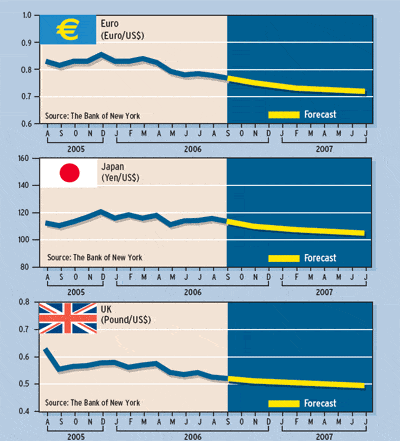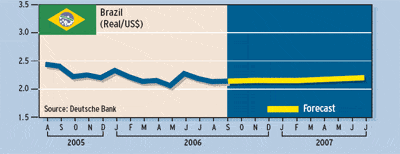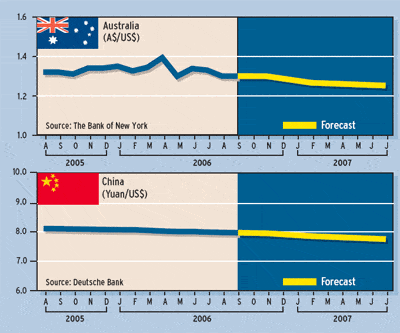FOREIGN EXCHANGE
Events this fall should see the return of the weak dollar, which will resume the move downward that stalled in June, says David Gilmore, economist and partner at Foreign Exchange Analytics, based in Essex, Connecticut.
Despite volatile inflation reports, the Fed is looking much farther down the road, and if its forecast assumptions hold up, this is the end of the tightening cycle, Gilmore says. This is the key dollar negative for the second half of 2006, and we could see Fed easing in 2007 if the housing market comes unbuttoned, he says.
US housing starts and building permits fell more than expected in July, with starts down 13% from a year earlier and permits off nearly 21%. Builders were less optimistic for the seventh month in a row in August, with sentiment declining to a 15-year low, according to the National Association of Home Builders. Meanwhile, the supply of new homes waiting to be sold reached a record high in June, the Census Bureau reported.
The Feds assumption that weak housing will translate into weak consumption is reasonable and warrants a wait-and-see approach to tightening, Gilmore says. Business spending is a relative disappointment, he says, because cash-rich firms are not going to beef up capacity when they sense a weakened consumer.
The other key ingredient to the weak dollar is the continued rate tightening by the European Central Bank, the Bank of England, the Swiss National Bank, the Bank of Japan and others, Gilmore says. Rest assured that none of these central banks is considering a two-year tightening cycle, but against a Fed on pause probably until year-end, the modest tightening abroad will be hard to ignore, and it will close nominal spreads that are currently favoring the dollar, he says.
Core consumer prices in the United States, which exclude food and energy, rose 0.2% in July from June, following four consecutive months of 0.3% increases. The dollar declined on the news of the modest improvement in the core inflation rate, which participants said increased the chances that the Fed would remain on hold through the end of the year.
The dollar will weaken to 1.40 to the euro by the end of the first quarter of 2007, Gilmore forecasts. The mid-term elections in the US this November could see a significant shift in the composition of Congress in favor of the Democrats, which could put downward pressure on US assets and the dollar, he says.
CURRENCY FORECASTS





A strong return of foreign investment into US treasury securities was evident in the Treasury international capital system, or TICS, report for June, which was the latest data available as Global Finance went to press. US net portfolio investment from foreign sources rose to more than $75 billion in June, exceeding market expectations and easily covering the June US trade deficit of $64 billion.
Foreigners bought a net $27 billion in US treasury bonds in June, up from $8.2 billion in May. It is clear that the global sell-off in equity markets in May and June prompted a bout of safe-haven flight from equities into bonds as an asset class, Woolfolk says. It also appears that the US benefited at the margin from its safe-haven status during periods of market instability.
In addition, growing petrodollar profits and continued Asian central bank intervention in the foreign exchange market are prompting natural demand for dollars, Woolfolk says. While the United Kingdom was the largest single source of net foreign investment into US securities during June, such investment is widely believed to include OPEC petrodollar flows from the Middle East, he says. The return of petrodollars via the UK was a positive development for both the US bond market as well as the dollar this summer.
Gilmore of Foreign Exchange Analytics says the never-ending geo-political risks are sure to keep oil prices high and possibly push them even higher. Iran has threatened it will stop selling oil to the world market and even close the Strait of Hormuz if sanctions are imposed on the country by the United Nations. Oil shocks have always fueled inflation, but the killer was always what they did to growth, he says.
The most telling reaction in the financial markets to the Federal Reserves decision in August to pause in raising rates came in the bond market, according to a report by State Street Global Markets, the investment research and trading arm of Boston-based State Street. Prices fell for longer-dated maturities of bonds, while they rose for short-term debt securities. The inverted yield curve has righted itself, suggesting the market believes the Fed can engineer a soft landing for the US economy in 2007, according to the report. The dollar weakened only slightly in immediate reaction to the Feds decision not to raise rates in August.
One question that has perplexed investors and policy-makers will soon begin to be answered, the State Street report says. What level of interest rates is sufficient to fund a current account deficit in excess of $800 billion at present exchange rates? The fear is that 5.25% is just not a high enough return to attract the flows of foreign capital needed, it says.
If rates are not high enough to attract foreign funds, then the dollar must fall to make US goods more competitive abroad in order for the US trade balance to improve, it adds. The fate of the dollar lies in Dr. Bernankes hands, the report concludes.
Gordon Platt



